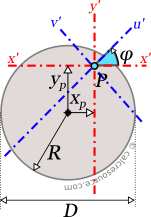
So again, I x why went from positive to negative almost with the same value, but an absolute value. Calculate the Second Moment of Area (or moment of. Calculate the Perimeter of a Half Circle. This method may be used to find the approximate value of the polar section modulus of sections that are nearly round. Using the structural engineering calculator located at the top of the page (simply click on the the 'show/hide calculator' button) the following properties can be calculated: Calculate the Area of a Half Circle. A standard method of denoting moment of inertia is to write the values as: number x. The polar section modulus (also called section modulus of torsion), Z p, for circular sections may be found by dividing the polar moment of inertia, J, by the distance c from the center of gravity to the most remote fiber. An arbitrary objects moment of inertia thus depends on the spatial distribution of its mass. Because millimetres are used, large numbers are generated in the calculation. This simple formula generalizes to define moment of inertia for an arbitrarily shaped body as the sum of all the elemental point masses dm each multiplied by the square of its perpendicular distance r to an axis k. In this case they are referred to as centroidal moments of. Calculating the moment of inertia ( I) For simple shapes such as squares, rectangles and circles, simple formulas have been worked out and the values must be calculated for each case. So we get here 1033 interests to the fore and we can figure out again the height, the distance here because we know the radius that we know the angle and that is this is that minus 873 inches to the fourth. Most commonly, the moments of inertia are calculated with respect to the sections centroid. By definition, the moment of inertia is the second moment of area, in other words the integral sum of cross-sectional area times the square distance from the axis of rotation, hence its dimensions are. And this gives us We know that we know again we know this angle here and this radio. So that gives us 2021 inches to the fourth. We know the radius and we know this angle. Since we know again, we just have this triangle here.

And so then we want to go 120 degrees on more circle around this way, so that gives us 60 point five degrees and so Now it's just a matter of doing the geometry to find this point. And that gives us 1000 and three interest in the fourth. We can calculate because we know this point and we know at this point and so we can calculate that. And we know that the center is at the average of these two things, so that's 1527 inches to the fourth. We know the area moments in the area, product about these access, and we know the angle through the principal axes, and that's about 30 degrees down here. So from previous problems, we know all this information.

So no, but something like use active is here. And we want to rotate the axes by 60 degrees counterclockwise. So here we're looking to use more circle to, um see how a axes rotation effects the area moments in the area product for this cross section. Moment of Inertia Moment of inertia, also called the second moment of area, is the product of area and the square of its moment arm about a reference axis.


 0 kommentar(er)
0 kommentar(er)
